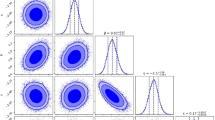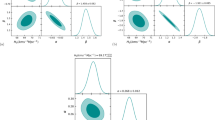Abstract
It has been shown that the axions produced in early universe can account for the cosmological dark matter. Theoretically, axions can decay and their decay rate can be greatly enhanced by stimulated emission of photons. In this article, we present a theoretical framework to describe the decay of the cosmological axion dark matter. We show that, for a certain parameter space of axion mass \(m_a\) and the axion–photon coupling constant \(g_{a \gamma \gamma }\), the axion decay would be significantly triggered so that no axion dark matter remains. For the popular benchmark models of the cosmological axion dark matter \(m_a \sim 10^{-5}\) eV, current observational constraints of the axion–photon coupling constant can ensure that axions are stable enough to be the cosmological dark matter.


Similar content being viewed by others
Data Availability Statement
The data underlying this article will be shared on reasonable request to the corresponding author. This manuscript has associated data in a data repository. [Authors’ comment: There is no extra data associated with this article.]
References
E. Aprile et al., Phys. Rev. Lett. 121, 111302 (2018)
M. Ackermann et al., Fermi-LAT Collaboration. Phys. Rev. Lett. 115, 231301 (2015)
M.H. Chan, C.H. Leung, Sci. Rep. 7, 14895 (2017)
K.N. Abazajian, S. Horiuchi, M. Kaplinghat, R.E. Keeley, O. Macias, Phys. Rev. D 102, 043102 (2020)
G. Ambrosi et al., Nature 552, 63 (2017)
M. Aguilar et al., Phys. Rev. Lett. 122, 041102 (2019)
A.E. Egorov, E. Pierpaoli, Phys. Rev. D 88, 023504 (2013)
T. Bringmann, M. Vollmann, C. Weniger, Phys. Rev. D 90, 123001 (2014)
M.H. Chan, L. Cui, J. Liu, C.S. Leung, Astrophys. J. 872, 177 (2019)
M.H. Chan, C.M. Lee, Phys. Rev. D 102, 063017 (2020)
M.H. Chan, Galaxies 9, 11 (2021)
D. Abecrcrombie et al., Phys. Dark Uni. 27, 100371 (2020)
R.D. Peccei, H.R. Quinn, Phys. Rev. Lett. 38, 1440 (1977)
S. Weinberg, Phys. Rev. Lett. 40, 223 (1978)
J. Preskill, M.B. Wise, F. Wilczek, Phys. Lett. B 120, 127 (1983)
L.F. Abbott, P. Sikivie, Phys. Lett. B 120, 133 (1983)
D. Grin, G. Covone, J.-P. Kneib, M. Kamionkowski, A. Blain, E. Jullo, Phys. Rev. D 75, 105018 (2007)
A. Salvio, A. Strumia, W. Xue, J. Cosmol. Astropart. Phys. 01, 011 (2014)
P.W. Graham, I.G. Irastorza, S.K. Lamoreaux, A. Lindner, K.A. van Bibber, Ann. Rev. Nuc. Part. Sci. 65, 485 (2015)
D.J.E. Marsh, Phys. Rep. 643, 1 (2016)
R.A. Battye, B. Garbrecht, J.I. McDonald, F. Pace, S. Srinivasan, Phys. Rev. D 102, 023504 (2020)
K. Ehret et al., Phys. Lett. B 689, 149 (2010)
V. Anastassopoulos et al., Nat. Phys. 13, 584 (2017)
A. Caputo, C.P. Garay, S.J. Witte, Phys. Rev. D 98, 083024 (2018)
A. Caputo, M. Regis, M. Taoso, S.J. Witte, J. Cosmol. Astropart. Phys. 03, 027 (2019)
A. Arza, Eur. Phys. J. C 79, 250 (2019)
D. Blas, S.J. Witte, Phys. Rev. D 102, 103018 (2020)
A. Arza, T. Schwetz, E. Todarello, J. Cosmol. Astropart. Phys. 10, 013 (2020)
E. Massó, R. Toldrà, Phys. Rev. D 52, 1755 (1995)
A. Ayala, I. Domínguez, M. Giannotti, A. Mirizzi, O. Straniero, Phys. Rev. Lett. 113, 191302 (2014)
E.L. Wright, Measuring and modeling the universe, from the Carnegie Observatories Centennial Symposia (Cambridge University Press, Cambridge, 2004)
P. van Dokkum et al., Nature 555, 629 (2018)
P. van Dokkum, S. Danieli, R. Abraham, C. Conroy, A.J. Romanowsky, Astrophys. J. 874, L5 (2019)
M.H. Chan, Sci. Rep. 11, 20087 (2021)
Acknowledgements
We thank the anonymous referee for useful comments. The work described in this paper was partially supported by a grant from the Research Grants Council of the Hong Kong Special Administrative Region, China (Project No. EdUHK 18300922).
Author information
Authors and Affiliations
Corresponding author
Rights and permissions
Springer Nature or its licensor (e.g. a society or other partner) holds exclusive rights to this article under a publishing agreement with the author(s) or other rightsholder(s); author self-archiving of the accepted manuscript version of this article is solely governed by the terms of such publishing agreement and applicable law.
About this article
Cite this article
Chan, M.H. The cosmological axion dark matter decay. Eur. Phys. J. Plus 138, 286 (2023). https://doi.org/10.1140/epjp/s13360-023-03877-7
Received:
Accepted:
Published:
DOI: https://doi.org/10.1140/epjp/s13360-023-03877-7




